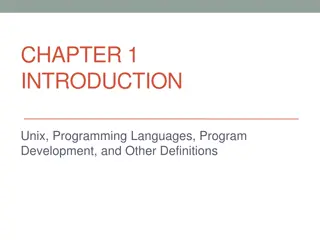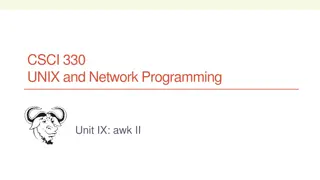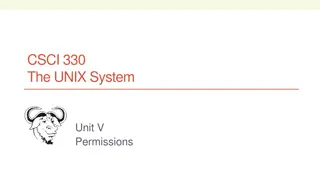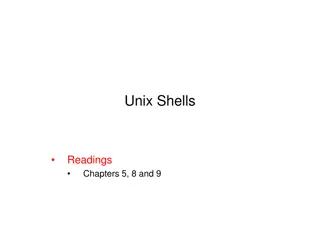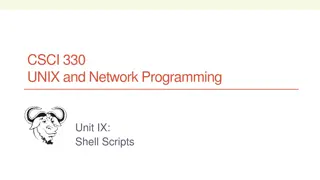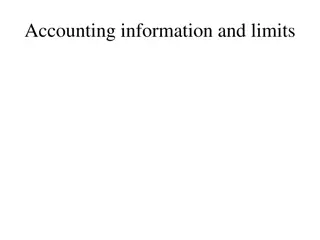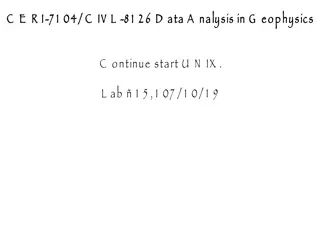Mastering UNIX Text Processing: Tips and Tricks
Explore the world of UNIX text processing through a comprehensive guide covering essential commands, efficient workflows, and powerful combinations. Learn how UNIX commands streamline tasks, eliminate redundant code, and enhance productivity. Discover the art of piping, output redirection, and utilizing a vast suite of tools to manipulate text streams effortlessly.
Download Presentation

Please find below an Image/Link to download the presentation.
The content on the website is provided AS IS for your information and personal use only. It may not be sold, licensed, or shared on other websites without obtaining consent from the author.If you encounter any issues during the download, it is possible that the publisher has removed the file from their server.
You are allowed to download the files provided on this website for personal or commercial use, subject to the condition that they are used lawfully. All files are the property of their respective owners.
The content on the website is provided AS IS for your information and personal use only. It may not be sold, licensed, or shared on other websites without obtaining consent from the author.
E N D
Presentation Transcript
Introduction to UNIX Text Processing Bo Yoo and Karthik Jagadeesh 19 Oct 2016
Stanford UNIX resources Host: cardinal.stanford.edu To connect from Unix/Linux/Mac: Open a terminal: ssh user@myth.stanford.edu ssh user@cardinal.stanford.edu ssh user@corn.stanford.edu To connect from Windows: SecureCRT/SecureFX (software.stanford.edu) PuTTy (http://goo.gl/s0itD)
Many useful text processing UNIX commands awk bzcat cat column cut grep head join sed sort tail tee tr uniq wc zcat UNIX commands work together via text streams. Example usage and others available at http://tldp.org/LDP/abs/html/textproc.html http://en.wikipedia.org/wiki/Cat_%28Unix%29#Other 3
Knowing UNIX commands eliminates having to reinvent the wheel For one of the homework questions in last year, to perform a simple file sort, submissions used: 35 lines of Python 19 lines of Perl 73 lines of Java 1 line of UNIX commands 5
Anatomy of a UNIX command command [options] [FILE1] [FILE2] options: -n 1 -g -c = -n1 -gc output is directed to standard output (stdout) if no input file is specified, input comes from standard input (stdin) - also means stdin in a file list To view the usage: command --help 6
The real power of UNIX commands comes from combinations through piping ( | ) Pipes are used to pass the output of one program (stdout) as the input (stdin) to another Pipe character is <Shift>-\ grep CS273a grades.txt | sort -k 2,2gr | uniq Find all lines in the file that have CS273a in them somewhere Sort those lines by second column, in numerical order, highest to lowest Remove duplicates and print to standard output 7
Output redirection (>, >>) Instead of writing everything to standard output, we can write (>)or append (>>) to a file grep CS273a allClasses.txt > CS273aInfo.txt cat addlInfo.txt >> CS273aInfo.txt 8
http://genomewiki.ucsc.edu/index.php/Kent_source_utilities UCSC KENT SOURCE UTILITIES 9
/afs/ir/class/cs273a/bin/ Many C programs in this directory that do manipulation of sequences or chromosome ranges Run programs with no arguments to see help message overlapSelect [OPTION] selectFile inFile outFile Many useful options to alter how overlaps computed selectFile inFile Output is all inFile elements that overlap any selectFile elements outFile 10
Kent Source and Mysql Linux + Mac Binaries http://hgdownload.soe.ucsc.edu/admin/exe/ Using MySQL on browser http://genome.ucsc.edu/goldenPath/help/mysql.h tml 11
Interacting with UCSC Genome Browser MySQL Tables Command line: mysql --user=genome --host=genome-mysql.cse.ucsc.edu -A Ne <STMT> e.g. mysql --user=genome --host=genome-mysql.cse.ucsc.edu -A Ne \ select count(*) from hg18.knownGene ; +-------+ | 66803 | +-------+ http://dev.mysql.com/doc/refman/5.1/en/tutorial.html 12
Other operations with bash/shell http://www.catonmat.net/blog/set- operations-in-unix-shell/ Bash noclobber: prevent overwriting files $ set -o noclobber $ echo "Can we overwrite it again?" >file.txt -bash: file.txt: cannot overwrite existing file $ echo "Can we overwrite it again?" >| file.txt Bash Dual pipes (tricky, be careful) sort <(cat file1) <(cat file2) 13
man, whatis, apropos UNIX program that invokes the manual written for a particular program man sort Shows all info about the program sort Hit <space> to scroll down, q to exit whatis sort Shows short description of all programs that have sort in their names apropos sort Shows all programs that have sort in their names or short descriptions
cat Concatenates files and prints them to standard output cat [OPTION] [FILE] A B C D 1 2 3 A B C D 1 2 3 Variants for compressed input files: zcat (.gz files) bzcat (.bz2 files) 16
head, tail head: first ten lines tail: last ten lines -n option: number of lines For tail, -n+K means line K to the end. head n5 : first five lines tail n73 : last 73 lines tail n+10 | head n 5 : lines 10-14 17
cut Prints selected parts of lines from each file to standard output cut [OPTION] [FILE] -d Choose delimiter between columns (default TAB) -f Fields to print -f1,7 : fields 1 and 7 -f1-4,7,11-13: fields 1,2,3,4,7,11,12,13 18
cut example file.txt CS a CS.273.a CS cut f1,3 file.txt = cat file.txt | cut f1,3 CS 273 a CS.273.a CS 273 a CS 273 a CS.a CS 273 a cut d . f1,3 file.txt In general, you should make sure your file columns are all delimited with the same character(s) before applying cut! 19
wc Print line, word, and character (byte) counts for each file, and totals of each if more than one file specified wc [OPTION] [FILE] -l Print only line counts 20
sort Sorts lines in a delimited file (default: tab) -k m,n sorts by columns m to n (1-based) -g sorts by general numerical value (can handle scientific format) -r sorts in descending order sort -k1,1gr -k2,3 Sort on field 1 numerically (high to low because of r). Break ties on field 2 alphabetically. Break further ties on field 3 alphabetically. 21
uniq Discard all but one of successive identical lines from input and print to standard output -d Only print duplicate lines -i Ignore case in comparison -u Only print unique lines 22
uniq example file.txt CS 273a TA: Cory McLean CS 273a uniq file.txt CS 273a CS 273a TA: Cory McLean CS 273a TA: Cory McLean CS 273a uniq u file.txt uniq d file.txt CS 273a In general, you probably want to make sure your file is sorted before applying uniq! 23
grep Search for lines that contain a work or match a regular expression grep [options] PATTERN [FILE ] -i ignore case -v Output lines that do not match -f <FILE>: patterns from a file (1 per line) -E Extended regex grep (=egrep) 24
grep example grep -E ^CS[[:space:]]+273$ file Then have one or more spaces (or tabs) For lines that start with CS And end with 273 Search through file file CS 273a CS273 CS 273 cs 273 CS CS 273 CS 273 273 25
tr Translate or delete characters from standard input to standard output tr [OPTION] SET1 [SET2] -d Delete chars in SET1, don t translate cat file.txt | tr \n , file.txt This is an Example. This,is an,Example., 26
sed: stream editor Most common use is a string replace. sed e s/SEARCH/REPLACE/g cat file.txt | sed e s/is/EEE/g file.txt ThEEE EEE an Example. This is an Example. 27
join Join lines of two files on a common field join [OPTION] FILE1 FILE2 -1 Specify which column of FILE1 to join on -2 Specify which column of FILE2 to join on Important: FILE1 and FILE2 must alreadybe sorted on their join fields! 28
join example file1.txt file2.txt Bejerano CS273a Villeneuve DB210 Batzoglou DB273a CS273a Comp Tour Hum Gen. CS229 Machine Learning DB210 Devel. Biol. join -1 2 -2 1 file1.txt file2.txt CS273a DB210 Bejerano Villeneuve Devel. Biol. Comp Tour Hum Gen. 29
Common shells Two common shells: bash and tcsh Run ps to see which you are using. 31
Multiple UNIX commands can be combined into a single shell script. Means die on error. script.sh script.csh #!/bin/bash set -beEu -o pipefail cat $1 $2 > tmp.txt paste tmp.txt $3 > $4 export A= Value #!/bin/tcsh -e cat $1 $2 > tmp.txt paste tmp.txt $3 > $4 setenv A Value Command prompt % ./script.sh file1.txt file2.txt file3.txt out.txt % ./script.csh file1.txt file2.txt file3.txt out.txt Scripts must first be set to be executable: % chmod u+x script.sh script.csh http://www.faqs.org/docs/bashman/bashref_toc.html http://www.the4cs.com/~corin/acm/tutorial/unix/tcsh-help.html 32
for loop # BASH for loop to print 1,2,3 on separate lines for i in `seq 1 3` do echo ${i} done should execute the command within the quotes Special quote character, usually left of 1 on keyboard that indicates we # TCSH for loop to print 1,2,3 on separate lines foreach i ( `seq 1 3` ) echo ${i} end 33
awk A quick-and-easy shell scripting language http://www.grymoire.com/Unix/Awk.html Treats each line of a file as a record, and splits fields by whitespace Fields referenced as $1, $2, $3, ($0 is entire line) 35
Anatomy of an awk script. awk BEGIN { } { } END { } before first line once per line after last line 36
awk example Output the lines where column 3 is less than column 5 in a comma-delimited file. Output a summary line at the end. awk -F', 'BEGIN{ct=0;} { if ($3 < $5) { print $0; ct=ct+1; } } END { print "TOTAL LINES: " ct; }' 37
Useful things from awk Make sure fields are delimited with tabs (to be used by cut, sort, join, etc. awk {print $1 \t $2 \t $3} whiteDelim.txt > tabDelim.txt Good string processing using substr, index, length functions awk {print substr($1, 1, 10)} longNames.txt > shortNames.txt Start position Length String to manipulate substr( helloworld , 4, 3) = low index( helloworld , low ) = 4 length( helloworld ) = 10 index( helloworld , notpresent ) = 0 38
Python A scripting language with many useful constructs Easier to read than Perl http://wiki.python.org/moin/BeginnersGuide http://docs.python.org/tutorial/index.html Call a python program from the command line: python myProg.py 39
Number types Numbers: int, float >>> f = 4.7 >>> i = int(f) >>> j = round(f) >>> i 4 >>> j 5.0 >>> i*j 20.0 >>> 2**i 16 40
Strings >>> dir( ) [ , 'capitalize', 'center', 'count', 'decode', 'encode', 'endswith', 'expandtabs', 'find', 'index', 'isalnum', 'isalpha', 'isdigit', 'islower', 'isspace', 'istitle', 'isupper', 'join', 'ljust', 'lower', 'lstrip', 'replace', 'rfind', 'rindex', 'rjust', 'rstrip', 'split', 'splitlines', 'startswith', 'strip', 'swapcase', 'title', 'translate', 'upper', 'zfill'] >>> s = hi how are you? >>> len(s) 15 >>> s[5:10] w are >>> s.find( how ) 3 >>> s.find( CS273 ) -1 >>> s.split( ) [ hi , how , are , you? ] >>> s.startswith( hi ) True >>> s.replace( hi , hey buddy, ) hey buddy, how are you? >>> extraBlanks .strip() extraBlanks 41
Lists A container that holds zero or more objects in sequential order >>> dir([]) [ , 'append', 'count', 'extend', 'index', 'insert', 'pop', 'remove', 'reverse', 'sort'] >>> myList = [ hi , how , are , you? ] >>> myList[0] hi >>> len(myList) 4 >>> for word in myList: print word[0:2] hi ho ar yo >>> nums = [1,2,3,4] >>> squares = [n*n for n in nums] >>> squares [1, 4, 9, 16] 42
Dictionaries A container like a list, except key can be anything (instead of a non-negative integer) >>> dir({}) [ , clear', 'copy', 'fromkeys', 'get', 'has_key', 'items', 'iteritems', 'iterkeys', 'itervalues', 'keys', 'pop', 'popitem', 'setdefault', 'update', 'values'] >>> fruits = { apple : True, banana : True} >>> fruits[ apple ] True >>> fruits.get( apple , Not a fruit! ) True >>> fruits.get( carrot , Not a fruit! ) Not a fruit! >>> fruits.items() [('apple', True), ('banana', True)] 43
Reading from files file.txt Hello, world! This is a file-reading example. >>> openFile = open( file.txt , r ) >>> allLines = openFile.readlines() >>> openFile.close() >>> allLines [ Hello, world!\n , This is a file-reading\n , \texample.\n ] 44
Writing to files >>> writer = open( file2.txt , w ) >>> writer.write( Hello again.\n ) >>> name = Cory >>> writer.write( My name is %s, what s yours?\n % name) >>> writer.close() file2.txt Hello again. My name is Cory, what s yours? 45
Creating functions def compareParameters(param1, param2): if param1 < param2: return -1 elif param1 > param2: return 1 else: return 0 def factorial(n): if n < 0: return None elif n == 0: return 1 else: retval = 1 num = 1 while num <= n: retval = retval*num num = num + 1 return retval 46
Example program Example.py #!/usr/bin/env python import sys # Required to read arguments from command line if len(sys.argv) != 3: print Wrong number of arguments supplied to Example.py sys.exit(1) inFile = open(sys.argv[1], r ) allLines = inFile.readlines() inFile.close() outFile = open(sys.argv[2], w ) for line in allLines: outFile.write(line) outFile.close() 47
Example program #!/usr/bin/env python import sys # Required to read arguments from command line if len(sys.argv) != 3: print Wrong number of arguments supplied to Example.py sys.exit(1) inFile = open(sys.argv[1], r ) allLines = inFile.readlines() inFile.close() outFile = open(sys.argv[2], w ) for line in allLines: outFile.write(line) outFile.close() python Example.py file1 file2 sys.argv = [ Example.py , file1 , file2 ] 48








